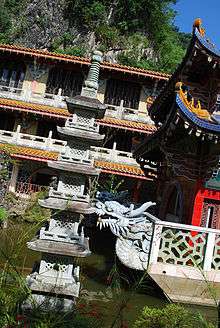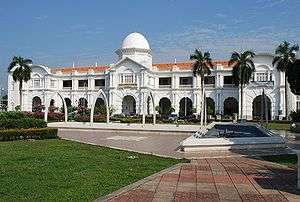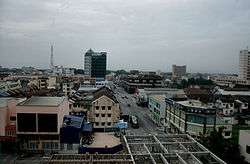Ipoh
| Ipoh City Bandar Ipoh | |||
|---|---|---|---|
| City and State Capital | |||
| Other transcription(s) | |||
| • Chinese | 怡保 | ||
| • Tamil | ஈப்போ | ||
| • Malay Jawi | إڤوه | ||
|
ipoh skyline | |||
| |||
| Nickname(s): City of Millionaires, Bougainvillea City, Silver Valley | |||
 Ipoh City | |||
| Coordinates: 4°35′40″N 101°05′00″E / 4.59444°N 101.08333°ECoordinates: 4°35′40″N 101°05′00″E / 4.59444°N 101.08333°E | |||
| Country |
| ||
| State |
| ||
| Establishment | Around 1880 | ||
| Government | |||
| • Mayor | Datuk Zamri Man | ||
| Area | |||
| • City and State Capital | 643 km2 (248 sq mi) | ||
| Elevation | 21.95 m (72 ft) | ||
| Population (2010) | |||
| • City and State Capital | 757,892 | ||
| • Density | 1,023/km2 (2,650/sq mi) | ||
| • Metro | 1,499,000[1] | ||
| Time zone | MST (UTC+8) | ||
| • Summer (DST) | Not observed (UTC) | ||
| Postcode | 30xxx, 31xxx | ||
| Area code(s) | 05 | ||
| Website |
mbi | ||
Ipoh /ˈiːpoʊ/ (Chinese: 怡保; pinyin: Yí bǎo Tamil: ஈப்போ) is the capital city of the state of Perak, Malaysia and also one of the largest cities in the country. It is approximately 200 km (120 mi) north of Kuala Lumpur and 130 km (81 mi) south of Penang on the North-South Expressway.
It is bordered by Batu Gajah in the west, Cameron Highlands in the east and Simpang Pulai in the south.
History
Its geographic location in the rich tin-bearing valley of the Kinta River made it a natural centre of growth. It grew rapidly as a mining town, especially in the 1920s and 1930s. A local Hakka miner, millionaire Yau Tet Shin, started developing a large tract of the city in the early 1930s, today known as the 'New Town', from the eastern bank of the Kinta River to Greentown.[2] In 1937, Ipoh was made the capital of Perak, replacing Taiping.
Ipoh was invaded by the Japanese on 15 December 1941. In March 1942, the Japanese Civil Administration or Perak Shu Seicho was set up at the St. Michael's Institution. After the liberation of Malaya by British forces, Ipoh remained the capital of Perak, till this day.[3]
Two of the largest entertainment groups then, the Cathay Organisation and Shaw Brothers Company, set up cinema chains in Ipoh.
Geography
Topography
Ipoh is in the state of Perak, which is in the northern part of Peninsular Malaysia. The city is in the middle of the Kinta Valley, on the bank of the Kinta River and the confluence of smaller rivers, Sungai Pinji and Sungai Pari. The city is surrounded by limestone hills, which can be found around suburban areas to the northeast, east and southeast.[4]
The Kledang mountain range stretches from the north to the west of the city. This range runs parallel to the Bintang mountain range with the Perak River flowing on its left bank and the Kinta River to its right. This range is interrupted to the north of Ipoh by a tributary of the Perak River called the Pelus River, which is sourced from the Titiwangsa mountain range, which runs to the east of Ipoh.[5]
Climate
Ipoh features a tropical rainforest climate. Temperatures are about the same throughout the year, showing little variation. The city's average temperature is 28 °C (82 °F). Ipoh sees high precipitation throughout the year with an average of 200 mm (7.9 in) of rain each month and averaging 2,427.9 mm (95.59 in) of rain per year. The wettest month is October where on average 297.2 mm (11.70 in) of rain is seen. Ipoh's driest month is January which has 132.3 mm (5.21 in) of rain fall on average.
| Climate data for Ipoh | |||||||||||||
|---|---|---|---|---|---|---|---|---|---|---|---|---|---|
| Month | Jan | Feb | Mar | Apr | May | Jun | Jul | Aug | Sep | Oct | Nov | Dec | Year |
| Average high °C (°F) | 32.9 (91.2) |
33.7 (92.7) |
33.9 (93) |
33.7 (92.7) |
33.5 (92.3) |
33.3 (91.9) |
33.0 (91.4) |
33.0 (91.4) |
32.5 (90.5) |
32.4 (90.3) |
32.1 (89.8) |
32.1 (89.8) |
33.0 (91.4) |
| Average low °C (°F) | 22.6 (72.7) |
23.0 (73.4) |
23.4 (74.1) |
23.9 (75) |
24.0 (75.2) |
23.7 (74.7) |
23.2 (73.8) |
23.3 (73.9) |
23.2 (73.8) |
23.1 (73.6) |
23.1 (73.6) |
22.8 (73) |
23.3 (73.9) |
| Average rainfall mm (inches) | 132.3 (5.209) |
149.8 (5.898) |
169.9 (6.689) |
259.1 (10.201) |
210.9 (8.303) |
151.8 (5.976) |
156.6 (6.165) |
157.8 (6.213) |
216.0 (8.504) |
297.2 (11.701) |
275.4 (10.843) |
251.1 (9.886) |
2,427.9 (95.587) |
| Average rainy days (≥ 1.0 mm) | 9 | 10 | 12 | 14 | 14 | 10 | 10 | 12 | 15 | 18 | 18 | 15 | 157 |
| Source: World Meteorological Organisation[6] | |||||||||||||
Limestone caves, mountains and lakes


Kek Lok Tong (Chinese: 極樂洞; Cavern of Utmost Happiness) is a cave temple that lies on the other side of the same hill as Sam Poh Tong. It is accessible through the Gunung Rapat housing area. It has a clean, quiet and cool environment.
Limestone hills extend 20 km (12 mi) north of Ipoh and 20 km (12 mi) to the south. There are many caves in these hills; cave temples are built in some.[7] Gua Tempurung, near Gopeng south of Ipoh, is a show cave open to the public. It is popular among spelunkers. More than 3 km (1.9 mi) long, it is one of the longest caves in Peninsula Malaysia. Part of it has been developed as a show cave with electric lighting and walkways, and there are tours of different lengths and difficulty. A fine river cave, the river passage runs about 1.6 km (0.99 mi) through the hill. There are five very large chambers and some stalactites and stalagmites.
Lakes in Ipoh include the one at Gunung Lang.

Cuisine
Ipoh has a vibrant food scene with a vast proliferation of hawker centres and restaurants. It is well known for dishes such as "Sar Hor Fun" (Chinese: 沙河粉) a complete one-dish rice noodle meal with prawn, meat, fish, vegetables and a savoury sauce. Other dishes from Ipoh include "Hor Hee", flat white rice noodles served with fish cakes and/or fish balls, "Nga Choi Kai" (Chinese: 芽菜鸡), chicken with soy sauce and beansprouts topped with pepper,"Kai Shi Hor Fun" (Chinese: 鸡丝河粉) rice noodles with Chicken, "Hakka Mee" (Chinese: 客家麵), yellow rice noodles served with mince meat (pork) sauce, and Ipoh's famous pastry "Heong Peng" (Chinese: 香餅), literally translated to "fragrant biscuit". The city is well known in Malaysia for its "Ipoh white coffee" where the coffee beans are roasted with palm-oil margarine and the resulting coffee is served with condensed milk. Ipoh is also famous for its fresh fruits such as Pomelo, Durian and Seedless Guava.
Cityscape
The Old Town
The Old Town is west of the Kinta River. There is a vibrant commercial district with many historical 'shop-houses' centred around Leech Street (Chinese: 烈治街; now Jalan Bandar Timah). Other notable features include:
- Ipoh railway station in neo-classical/Edwardian Baroque style nicknamed the "Taj Mahal of Ipoh".
- Ipoh Town Hall, an Edwardian Baroque municipal building located across the road from the Railway Station.
- Padang Ipoh or Ipoh Field is on Jalan S.P. Seenivasagam. The field is surrounded by historic buildings that feature classic colonial architecture, including the mock-Tudor style Ipoh Club, FMS Bar, HSBC Building and the St Michael's Institution secondary school.
- The Anglo-Chinese School, Ipoh, officially named SMK Methodist (ACS), is located along Lahat Road.
- Sekolah Menengah Kebangsaan Anderson is the most well-known secondary school with more than 100 years of history, located beside the General Hospital of Ipoh. This school has been producing numerous of figures in the country.
- St. Michael's Institution, Ipoh, is a public secondary school in Ipoh, Perak, Malaysia. It is situated on Jalan S. P. Seenivasagam, formerly Clayton Road.
- Han Chin Pet Soo, the Hakka Tin Miner's Club, located on Jalan Bijeh Timah (formerly Treacher Street) has been restored and turned into Malaysia's First Hakka Tin Mining Museum.
- Muzium Darul Ridzuan is a historical museum of Perak, in a pretty former tin-mining tycoon's mansion on Jalan Kuala Kangsar.
The New Town

The so-called New Town, to the east of the Kinta River, was developed by Yau Tet Shin around 1908.[2] The New Town houses the Perak Medical University and Ipoh City Hall building, among others. There are numerous shops, shopping malls, and hotels.
D. R. Seenivasagam Park (Coronation Park), located in the heart of Ipoh (New Town), is known for its scenic beauty and recreational facilities. It comprises recreational fields, an artificial lake filled with fish, a nursery for potted plants and a children's traffic playground. The latest addition is the newly landscaped Japanese garden featuring a Japanese carp pond.
Sports
For golf, the courses are the Royal Perak Golf Club off Jalan Sultan Azlan Shah (Tiger Lane), the Meru Golf Club in Jelapang, and Clearwater Sanctuary Golf Club en route to Batu Gajah.
Other sports venues include the Kilat Club in Pasir Pinji, Ipoh Field (Padang Ipoh) in the Old Town, the Polo Grounds, and the Iskandar Polo Club, in Ampang Baru.
The Sultan Azlan Shah Cup is an annual international men's field hockey tournament held in Ipoh.
Governance
The Ipoh City Council governs the city. Datuk Zamri Man, appointed in August 2015, is the current mayor of Ipoh.[8]
Ipoh is divided into two parliamentary constituencies: Ipoh Barat (Ipoh West) and Ipoh Timur (Ipoh East). The parliamentary seat for Ipoh Timur is held by DAP Representative, Su Keong Siong, which was formerly held by Lim Kit Siang while the seat for Ipoh Barat is held by fellow DAP leader, M. Kulasegaran.[9]
Demographics
Ipoh remains one of Malaysia's largest cities. It is the fourth largest city in Malaysia. As of 2010, the municipal area of Ipoh has a population of 657,892.[10] It ranks as the seventh most populous urban centre in Malaysia (2010).[10]
The following is based on Department of Statistics Malaysia 2010 census.[10]
| Ethnic groups in Ipoh, 2010 | ||
|---|---|---|
| Ethnicity | Population | Percentage |
| Chinese | 290,165 | 44.11% |
| Bumiputera | 253,592 | 38.55% |
| Indian | 92,587 | 14.07% |
| Others | 1,559 | 0.2% |
| Non-Malaysian | 19,989 | 3.04% |
Toponymy
The name Ipoh is derived from a local tree, Pohon Epu or now more commonly known as Pokok Ipoh. The sap of this plant is poisonous and was used by Orang Asli (indigenous peoples in Malay) to coat the tips of the darts of their blowpipes for hunting.
Transportation

- Trunk roads: The old interstate Route
 connects Ipoh with other major towns and cities in peninsular Malaysia, for example to Alor Setar, Taiping and Penang to the north and Tapah, Kuala Lumpur, Seremban and even Johor Bahru in the south. Motorists from the east coast can use highway
connects Ipoh with other major towns and cities in peninsular Malaysia, for example to Alor Setar, Taiping and Penang to the north and Tapah, Kuala Lumpur, Seremban and even Johor Bahru in the south. Motorists from the east coast can use highway  (from Gerik in northern Perak or
(from Gerik in northern Perak or  (from Cameron Highlands).
(from Cameron Highlands). - Highway: The new North-South Expressway
 is a faster and more efficient alternative to Route 1. However, certain towns like Kampar can only be accessible via Route 1.
is a faster and more efficient alternative to Route 1. However, certain towns like Kampar can only be accessible via Route 1. - Train: Ipoh's railway station is operated by Keretapi Tanah Melayu (KTM) and is in the Old Town (however, it does not have intra-city travel like in Kuala Lumpur). The railway only connects Ipoh with neighbouring towns and cities. The station is a stately building, referred to by locals as the 'Taj Mahal' of Ipoh. KTM Intercity began the Shuttle Train Service between Kuala Lumpur and Ipoh from 1 December 2008 while the modern Electric Train System (ETS) shuttle began from 12 August 2010 with average 145 km/h (90 mph) speed, plying Ipoh-Seremban route, cut the travelling distance between Ipoh and Kuala Lumpur into 120 minutes. There are 10 dedicated shuttle train services between these two cities daily which begins at 5 am from both the stations. Travel time between the cities was expected to be reduced from three hours to two hours and fifteen minutes when the new set of EMU trains arrived in mid-2009.[11]
- Bus: The inter-city bus terminal is located at Amanjaya integrated bus terminal in Bandar Meru Raya, just north of the city.
- Air: the Sultan Azlan Shah Airport is the only airport in Ipoh. It is near Gunung Rapat. Domestic flights and international ones are available. Tigerair provides four flights weekly out of Ipoh to Singapore Changi Airport. Firefly provides two daily flights out of Ipoh to Singapore Changi Airport as well as Johor Bahru while Malindo Air provides daily flights to Johor Bahru, Medan and Kuala Lumpur-Subang.
Notable people
Film and Television:
- Angie Cheong,
- Mimi Chu,
- Iqram Dinzly
- Mamat Khalid
- Peter Pek
- Afdlin Shauki
- Patrick Teoh
- Michelle Yeoh
Music:
- Michael Wong
- Jamal Abdillah
- Shila Amzah
- Ning Baizura
- Francissca Peter
- Sam Chin Neng of Fuying & Sam
Sports: (Badminton):
Sports (Football):
Sports (Others):
- Tony Underwood (Rugby)
- Nur Suryani Mohd Taibi (Sports shooting)
- Leong Mun Yee (Diving)
Business:
- David Ho Sue San of Hovid Berhad & Carotech Berhad,
- Lee Loy Seng (founder of Kuala Lumpur Kepong Berhad),
- Dr. Wong Jeh Shyan CEO of CommerceNet Singapore Limited,
Politics:
- Yeoh Ghim Seng
- Dr Yeoh Eng Kiong
- S. J. V. Chelvanayakam
- Ahmad Husni Hanadzlah
- D. R. Seenivasagam
- Lim Keng Yaik
- Lee Lam Thye
Historical:
- Yusof bin Ishak (president of Singapore)
- Leong Sin Nam
- Wu Lien-teh
- Foo Choo Choon
- Leong Fee
- Chung Thye Phin
- Eu Tong Sen
Science and technology:
- Lam Wei Haur(Professor Dr)
Other:
- Chan Sek Keong (Chief Justice of Singapore)
- Lat (cartoonist)
Film and television
Movies filmed in Ipoh include:
- 1992: Indochine
- 1999: Anna and the King
- 2004: Tun Tan Cheng Lock
- 2005: Sepet
- 2005: Gubra
- 2006: After This Our Exile (Chinese 父子)
- 2006: Goodbye Boys
- 2006: Lust, Caution (Chinese: 色,戒)
- 2015: Blackhat
International relations
Sister cities
Ipoh currently has two sister cities:
See also
 |
Kuala Kangsar | Sungai Siput Chemor |
Hulu Kinta Lojing |
 |
| Manong | |
Lojing Cameron Highlands | ||
| ||||
| | ||||
| Parit | Batu Gajah | Simpang Pulai |
References
- ↑ http://www.statistics.gov.my/portal/download_Population/files/BPD/ad_2010.pdf
- 1 2 Ipohworld’s World » Yau Tet Shin’s New Town Under Construction 1908. Ipohworld.org. Retrieved 27 September 2013.
- ↑ Khoo Salma Nasution & Abdur-Razzaq Lubis, Kinta Valley: Pioneering Malaysia's Modern Development, Ipoh: Perak Academy, 2005. pp. 273–292
- ↑ "Limestone Hills (Bukit Batu Kapur), Ipoh, PERAK – Malaysia Travel Review". Malaysiahotelreview.com. Retrieved 10 December 2013.
- ↑ Jacq-Hergoualc'h, Michel; Victoria Hobson (September 2002). The Malay Peninsula: Crossroads of the Maritime Silk Road (100 BC – 1300 AD). BRILL. ISBN 90-04-11973-6.
- ↑ "World Weather Information Service – Ipoh". World Meteorological Organisation. Retrieved 7 May 2014.
- ↑ "Home". Cavesofmalaysia.com. Retrieved 10 December 2013.
- ↑ "New mayor for Ipoh sworn in – Community | The Star Online". The Star. Malaysia. Retrieved 11 November 2015.
- ↑
- 1 2 3 "Population Distribution by Local Authority Areas and Mukims, 2010" (PDF). Department of Statistics Malaysia. Archived from the original (PDF) on 27 February 2012.
- ↑ "Malaysia / Perak / The Ipoh Railway Station". Cockatoo.com. 14 November 2011. Retrieved 10 December 2013.
- ↑ "Guangxi signed cooperation project of US$400 million with Malaysia". Ministry of Commerce, People's Republic of China. 6 April 2005. Archived from the original on 20 December 2015. Retrieved 20 December 2015.
- ↑ "Exchange with sister cities". Fukuoka City. 23 April 2009. Archived from the original on 20 December 2015. Retrieved 20 December 2015.
External links
| Library resources about Ipoh |
| Wikimedia Commons has media related to Ipoh. |
-
 Ipoh travel guide from Wikivoyage
Ipoh travel guide from Wikivoyage - Ipoh Tourism Board Official Website



